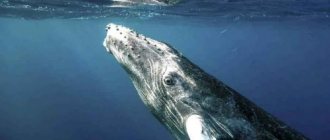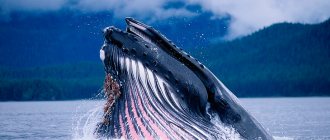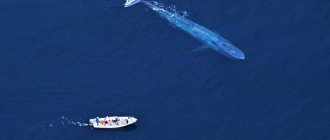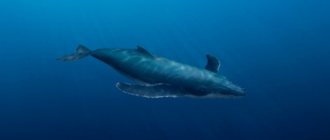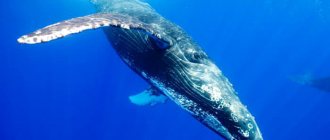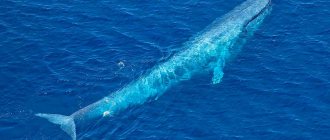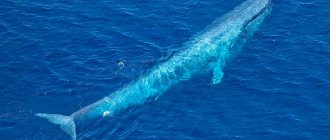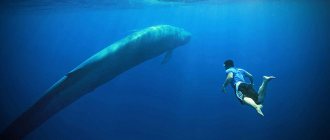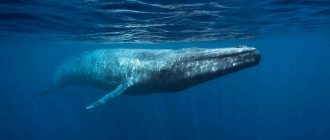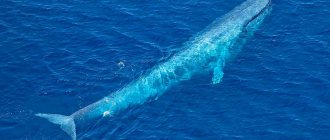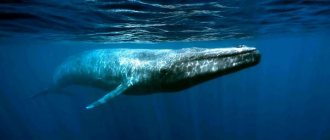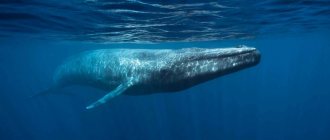Whale watching is one of the types of eco-tourism. Entire expeditions are organized all over the world, the purpose of which is to admire these amazing animals, learn more about their way of life, and take unique memorable photographs.
In Russia, you can also see whales live - there are several regions where they are common and where you can go as part of a tourist group. By the way, we recommend watching whales only with an experienced guide, who will not only select the most suitable time for a boat trip, but also share interesting facts about the largest animals on the planet.
Why whales are interesting
Many people think that whales are fish. This is wrong. Cetaceans are mammals that give birth to young and feed them milk.
Whales, in the process of evolution, moved from land to water and fully adapted to living in water. They experienced a huge number of different changes in their bodies. For example, they completely lost their hind limbs, which interfered with swimming and created unnecessary turbulence. The whales' nose has migrated to the crown of the head - this allows them to simultaneously breathe and keep their muzzle under water to hunt. The fountain that the whale releases when it rises to the surface is actually an exhalation of air.
Most species are herd animals, living in families or in groups of several hundred to thousands of animals. Cetaceans migrate within familiar territories and adhere to certain routes and times.
Unfortunately, in the recent past, almost all parts of the body of whales were used by people to produce food and technical products. Because of this, many species are on the verge of extinction. There is currently a moratorium on commercial cetacean fishing, but limited fishing is available in some countries.
There is a scientific opinion that whales have their own language. Bioacoustics and linguistics studies whale signals at the level of sound amplitudes and frequencies. They can communicate with each other both over short and long distances.
10 Amazing Facts About Whales
- Thanks to the thick layer of fat under their skin, whales can swim in icy water.
- Whales can go without eating for about 10 months and without sleeping for more than 100 days.
- Blue whales are the largest animals that have ever lived on the planet. The body length of an adult blue whale can reach 33 meters, and its weight can exceed 150 tons.
- Whales pump more than almost 10,000 liters of blood, and the diameter of their vessels is comparable to the diameter of a bucket.
- Whales can hold their breath for several hours.
- Whales do not have ears; the hearing organ is the lower jaw.
- Some species of whales can live more than 100 years.
- Whales and humans are the only mammals that “sing songs.” The most melodic sounds are made by white whales.
- Before the ban on whaling, margarine, theatrical makeup, lubricants, soap, washing powder, glycerin and other substances were produced from the blubber and blubber of whales.
- Ambergris, a substance that is formed in the intestines of sperm whales, is valued in the perfume industry as a perfume fixative.
What you need to know before your trip
Since boats with tourists go out to the ocean early in the morning and spend up to 5 hours on the open sea, it would be a good idea to go to bed early the night before the trip.
Seasickness can ruin your entire trip. Prepare in advance, buy the pills and don't forget to take the packets with you, just in case.
Boats are prohibited from sailing too close to the whales. If you want to get a better look at them, consider bringing a good pair of binoculars.
It is prohibited to use food, make noise or try to attract the attention of whales in other ways. Swimming with whales is permitted only with the consent of the ship's captain.
Where can you see whales in Russia
Shantar Islands
This place is difficult in terms of weather conditions. There is ice here until July. But you can see large and amazing bowhead whales. They are also found in Chukotka, but in Shantar they can be seen best. These sea giants are the northernmost whales in the world; they are also called polar whales. Despite this, they are quite active and are not afraid of boats, so it is highly likely that you will see them while traveling.
Go on a tour
Chukotka
Chukotka is a harsh region, but local residents managed to adapt to its conditions thousands of years ago. Here you will not only discover the secrets of the ancient culture of sea hunters, but also watch pods of gray whales, walruses, and numerous bird colonies. Also here you will witness whale hunting, which is officially permitted for the Chukotka population within the framework of quotas. To see how Chukotka whalers work, you need to get to the village of Lorino. The Chukchi, like other indigenous peoples of the North, can catch 140 gray whales per year according to Whaling Commission quotas.
Go on a tour
Kurile Islands
On the islands you can find humpback whales, minke whales, gray whales, killer whales, and several species of seals. However, the main character of the Kuril Islands is the Japanese right whale. Outwardly, it is indistinguishable from the North Atlantic right whale, but it is slightly larger and can reach a length of 18.5 m. Females are slightly larger than males. The weight of representatives of this species is up to 80 tons. Japanese whales are large, dark, and do not have a dorsal fin. The surface of the head and lower jaws is covered with horny cones in the form of large warts.
In addition to whales, on the Kuril Islands you can watch killer whales - the only predators among cetaceans that pursue warm-blooded animals.
Solovetsky Islands, White Sea
The main habitat here is beluga whales, a species of toothed whale from the narwhal family. The skin color of beluga whales is uniform and changes with age: newborns are blue, after a year they become bluish-gray, and individuals older than 3–5 years are pure white. The largest males reach 6 m in length and 2 tons in weight, females are smaller. The beluga has a small, “browed” head, without a beak. The vertebrae in the neck are not fused together, so the beluga whale, unlike most whales, is able to turn its head. There are scientists working on the Solovetsky Islands who can tell you a lot of information about beluga whales and their way of life.
Kamchatka
Kamchatka is home to one of the most famous species of whales - the humpback or humpback whale. This is a species of marine mammal of the minke whale family from the order of baleen whales. The only modern species of the humpback whale genus. It got its name either because of its dorsal fin, which is shaped like a hump, or because of its habit of arching its back strongly when swimming. You are guaranteed to see humpback whales here. You can come to Petropavlovsk-Kamchatsky for a few days and watch humpback whales, killer whales and sperm whales. If you wish, you can spend several days at sea to get even closer to amazing marine life.
Commander Islands
Experienced tourists come here who have long been interested in whales and want to see a rare species of cetaceans - beaked whales. These are small and medium-sized cetaceans with a body length of 3.4–13 m and a weight of 1–15 tons. The largest of the beaked whales is the northern swimmer - this is the second largest (after the sperm whale) toothed whale. The snout is elongated into a long, tapered, cone-shaped beak. Some beaked whales have a developed fat pad on their forehead. The color is usually uniform gray or brown, sometimes with white spots. Beaked whales have a unique ability - they can dive to depths of up to 4 kilometers to hunt for deep-sea mollusks.
Franz Josef Land
Franz Josef Land is a legendary place in terms of territorial development. There are many different species of whales found here, but getting here is quite difficult. The waters of the archipelago are home to mysterious narwhals, bowhead whales, minke whales, humpback whales and other species of cetaceans.
The most striking species of all is the narwhal - a mammal of the narwhal family, the only species of its genus. Because of their long horn, they are also called Arctic unicorns. The body length of an adult narwhal reaches 3.8–4.5 m, and the weight of males is 2–3 tons, of which a third of the weight is fat. Females weigh about 900 kg. The head is round, with an overhanging frontal tubercle, and there is no dorsal fin. The mouth is small, located below.
Trincomalee
Trincomalee can be considered a wild place with no developed infrastructure, compared to Mirissa and Kalpitiya. But if you head east of Trincomalee (the journey takes about 30 minutes), you can spot blue whales. If you get seasick from sea walks, then you can even watch whales in Sri Lanka from land. To do this you will need to climb Mount Swami. Quite sharp rocks and a cliff, from here you can see whales swimming along the coast, raising their huge tail above the surface and then disappearing into the depths of the sea.
Near the small village of Nilaveli is the Pigeon Island National Park, which is home to coral reefs and a large number of fish. Here you can go snorkeling and, if you’re lucky, swim in the company of turtles and maybe even whales.
You can see whales in Sri Lanka in Trincomalee from March/April to August/September.
In each of the cities there are excursion companies that organize whale safari. For example, in the most popular resort of Sri Lanka, Mirissa, there is Raja & Whales. Tourists are advised to choose this company, since only this company has official permission to swim in the open ocean. This means that a walk through the waters in search of whales will be more comfortable and safer than with.
Countries where you can still see whales
Mexico
Humpback and gray whales can be seen here. They live in Cabo San Lucas, Puerto Vaillard and Southern Baja California. San Lucas has whale lagoons and Banderas Bay. You can even see families with babies on the coast of Mexico.
Iceland
The city of Húsavik is the whale capital of Iceland. There are many offers for those who want to go out to sea and see whales. And Reykjavik is home to the world's only whale museum. Unfortunately, whale fishing is now allowed in Iceland, despite the fact that this is contrary to international agreements.
Norway
In Norway, whales are found all year round. There are especially many of them near the Lofoten Islands. The Lofoten Islands also attract killer whales - they can be seen from October to January, when there are a lot of herring in the sea. Unfortunately, observing amazing animals on the islands is not very comfortable - they are located above the Arctic Circle, and therefore it is quite cold there.
South Africa
Almost the entire South African coastline is suitable for whale watching from June to November. But the coast near the city of Hermanus especially stands out. This city is considered the whale capital of the world. Whales come to this place to give birth and stay here until the babies grow up. Every year Hermanus hosts a whale festival from 30 September to 4 October. The animals are observed directly from the shore, where benches and stands are installed specifically for this purpose.
Spain (Bay of Biscay)
The Bay of Biscay off the coast of Spain is a great place in mainland Europe to see whales. There are especially many of them here near the islands of La Gomera and Tenerife in May and summer.
New Zealand(Kaikoura)
In New Zealand, whales can be found off the coast of the South Island all year round. The most popular place is Kaikoura. Cold and warm currents converge here, which creates favorable conditions for whales due to the underwater world rich in vegetation.
Canada
Canada is home to many different whales, including humpback whales, killer whales, minke whales, blue whales, fin whales and, in some cases, beluga whales.
Hot spots include Newfoundland and Labrador, as well as Tadoussac, where you'll find plenty of boat and land tours, not to mention these areas are popular with tourists, so you can often find cheap accommodation and lively atmosphere.
Don't miss: 8 facts everyone should know about the Australian fires
For something special, head to Tofino in March, when the region's gray whale migration takes place—an event the city celebrates with its annual Pacific Whale Festival.
Greenland Island
It is best for whale lovers to come here in April, and the most suitable place to observe these mammals is to choose the coast of Aasiaat, Nuuk or the port of Qeqertarsuaq. Eight species of whales are found in the local waters of the Atlantic and Arctic oceans surrounding Greenland, the most common being humpback and minke whales.
Reproduction
The majority of cetaceans have offspring every two years. In some species (humpback whales, sperm whales), females and calves spend most of the year in warm waters, while males fatten up in cold waters, where they feed for future use. But during the mating season, they return to choose a partner for procreation. Fights between males for females are common.
Pregnancy lasts from 7-8 to 18 months depending on the species. Migratory species give birth to their offspring in warm waters. Childbirth takes place in water. One baby whale is born, very rarely two. Newborn whales are large, immediately able to move independently and develop quickly. Whale milk is very fatty and nutritious; the feeding period lasts more than a year, and sometimes more than 2 years.
Female vomiters produce up to 200 liters of milk per day. The cubs feed underwater. The baby whale consumes milk in small portions, but very often.
Whales have a developed maternal instinct; the bond between mother and baby is strong and long-lasting. Some species are characterized by collective care for their offspring; the mother can feed not only her baby. Animals gather in groups to jointly raise their offspring and defend themselves from possible enemies.
Yandex pictures
